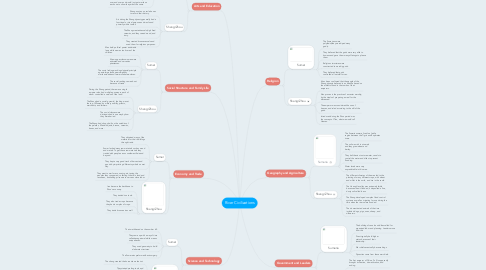
1. Social Structure and Family Life
1.1. Sumer
1.1.1. Men held political power and made laws while women took care of the children.
1.1.2. A few upper-class women were educated and served as priestesses.
1.1.3. The social raking was kings/priests/principle agents-large landowners/wealthy merchants-artisans/farmers/laborers-slaves.
1.1.4. The social ranking came about because of trade.
1.2. Shang/Zhou
1.2.1. During the Shang period, there was a single emperor who had multiple governors, each of whom controlled a section of the land.
1.2.2. The Shang had a social pyramid, the king was at the top, followed by military nobility, priests, merchants, and farmers.
1.2.3. The social classes were distinguished in one way by how they were buried.
1.2.4. The Shang had shops built on the outskirts of the palaces, filled with jade, bronze, ceramics, bones, and more.
2. Economy and Trade
2.1. Sumer
2.1.1. They obtained many of the materials for their buildings through trade.
2.1.2. Sumer lacked many raw materials such as wood and metals. To get these raw materials they traded with people across southwest Asia and beyond.
2.1.3. They kept a very good track of harvest and goods by imprinting different symbols on wet clay.
2.1.4. They went to war for economic gain, taxing the peoples they conquered, collecting tribute in land and resources, and taking prisoners to serve as slave labor.
2.2. Shang/Zhou
2.2.1. Iron became the backbone to Zhou's economy.
2.2.2. They traded iron tools.
2.2.3. They also trade crops because they had a surplus of crops.
2.2.4. They trade bronze art as well.
3. Science and Technology
3.1. Sumer
3.1.1. Their math based on the number 60.
3.1.2. They came up with a way of time called sexagesimal which means unique bases.
3.1.3. They used geometry to build elaborate structures.
3.1.4. The Sumerains preformed basic surgery.
3.2. Shang/Zhou
3.2.1. The shang created the horse drawn chariot.
3.2.2. They started making tools and object outta bronze materials.
3.2.3. A hot piece of metal would be put on an orcal born and it would crack the bone then given to a high priest to interpret the cracks to get answers.
3.2.4. They built their calendar off the cycle of the moon.
4. Arts and Education
4.1. Sumer
4.1.1. They wrote on wet clay and their writing was called cuneiform.
4.1.2. Before they used imprints on wet clay surfaces they used clay tokens.
4.1.3. They came up with the writing system and the writing style was wedge shaped.
4.1.4. The Sumerians would used the same pictures over and over and would just put marks on each one to show they aren't the same.
4.2. Shang/Zhou
4.2.1. Shang wrote on oracle bones to record their history.
4.2.2. Art during the Shang dynasty generally had a functional or ritual purpose and was found primarily within tombs.
4.2.3. The Shang created vessels,high fired ceramics,and they carved wood, and ivory.
4.2.4. They created bronze vessels and used them for religious purposes.
5. Religion
5.1. Sumer
5.1.1. The Sumerians were polytheist(they worshiped many gods).
5.1.2. They believed that the gods were very alike to humans and gave them many offerings to please them.
5.1.3. Religious structures were constructed to worship gods.
5.1.4. They believed that gods controlled all natural forces.
5.2. Shang/Zhou
5.2.1. It has been confirmed that the people of the Shang dynasty believed in an afterlife based on the artifacts found in the tombs of their emperors.
5.2.2. Also proven is the practice of ancestor worship, by the rituals of preparing a meal for the deceased.
5.2.3. The emperor was considered the son of heaven, and ruled according to the will of the gods.
5.2.4. Introduced during the Zhou period was the concept of Tian, what we would call Heaven.
6. Geography and Agriculture
6.1. Sumaria
6.1.1. The Sumerians were lived in a fertile region between the Tigris and Euphrates rivers.
6.1.2. The soil was rich in minerals and they grew wheat and barley.
6.1.3. They built basins to store water, canals to control the water and dikes to prevent flooding.
6.1.4. Water levels were very unpredictable in this area.
6.2. Shang/Zhou
6.2.1. The different climates of the area led to the planting of many different crops, with wheat and millet in the north, and rice in the south.
6.2.2. The Huang He valley was extremely fertile because when it flooded, it deposited a fine, dusty soil called loess.
6.2.3. The Shang developed complex flood control systems as well as irrigation for use during the time when the rivers were flooded.
6.2.4. The domesticated animals of the time included dogs, pigs, oxen, sheep, and silkworms.
7. Government and Leaders
7.1. Sumeria
7.1.1. The building of canals and dikes called for organized labor and planning. Leaders arose from this
7.1.2. Priest typically held higher status because of their leadership.
7.1.3. War chiefs eventually became kings.
7.1.4. Dynasties came from these war chiefs.
7.2. Shang/Zhou
7.2.1. The first emperor of China, Fu Xi supposedly brought civilization, domestication, and writing.
7.2.2. One of the first dynasties of China was the Shang dynasty, known for it's strong monarchy and system of governors.
7.2.3. The Zhou dynasty is normally separated into two sections, the Western Zhou and the Eastern Zhou.
7.2.4. The Mandate of Heaven was used throughout many Chinese dynasties as the reason that the previous dynasty had fallen, it stated that the ruling dynasty was supported by the gods.
